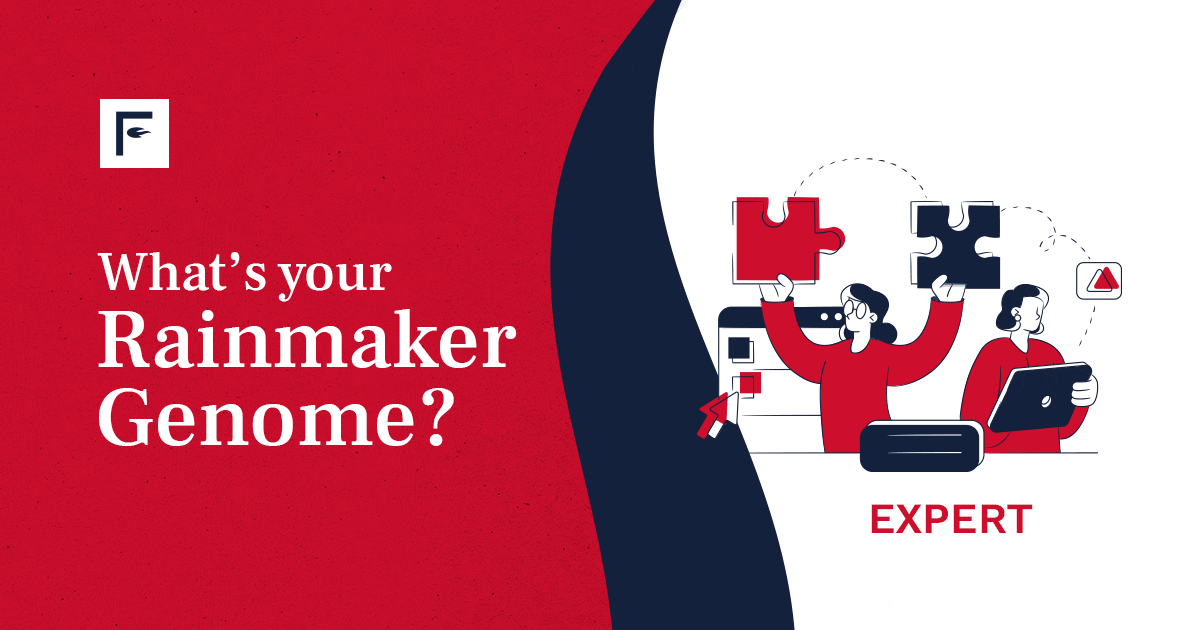When it comes to legal rainmakers, researchers have identified five specific types – and determined which is most likely to succeed.
The Rainmaker Genome Project, a survey sponsored by Intapp and conducted by DCM Insights, was shared at the 2023 Legal Marketing Association annual meeting this week. Studying more than 1,600 partners in professional services firms, the researchers charted 108 total attributes of business development, from social networking activity to use of pitch materials to strength of individual client relationships. Layered over this was performance data from the participating firms.
The result: Five statistically-defined business development approaches…and the data to show which works best.
What’s Your Type?
Expert: Described as “reluctant business developers,” Experts generally respond to established demand rather than working to create it. They look for clients with well-defined needs that match their specific skill set. They are known to include lots of details and examples in proposals to illustrate their fit for the given opportunity.
Confidant: Known for white-glove service, Confidants develop deep personal relationships, typically with the most senior individuals at a client company, such as the general counsel or CEO. They are appreciated for high levels of responsiveness and leverage their track records to expand their work.
Activator: While the Confidant builds deep one-on-one relationships, Activators construct robust networks that are deep and wide; they will engage with people at all levels of a client organization, and they seek to connect clients to their colleagues as well. They educate clients on trends and issues and proactively seek new opportunities.
Debater: The contrarians among rainmakers, Debaters bring a different point of view – but one backed up by deep subject-matter expertise. They enjoy sparring with clients on the best course of action, and they want to work with clients who will follow their lead.
Realist: Realists earn trust through candor and transparency. They will be the first to talk budget and fees, and they are comfortable telling clients and prospects “no.” Realists will walk away from projects that they deem as no-win or that they see as harmful to their teams.
Rainmakers in the Wild
While most firms will have all five types, distribution is not equal. Within the legal sector, the population skews heavily toward the Confidant, comprising 41 percent of all rainmakers. This is more than double the percentage of all other types; Activator and Realist each made up 16 percent, with Expert and Debater at 15 percent and 13 percent, respectively.
Interestingly, Confidant also is the most abundant rainmaker type in professional services at large, although by a smaller margin. Across all professional services businesses, 26 percent of rainmakers are Confidants, followed by Realist (24 percent), Activator (20 percent), Expert (18 percent) and Debater (14 percent). (With respect to the higher Realist rate, it’s not surprising that bankers and accountants may be more comfortable with budget talks than their attorney counterparts.)
So Confidant is the most common type of rainmaker – but it turns out they are not the most effective. In fact, according to the study, the Confidant type had the highest number of low performers.
At the top? The Activator, with both the highest percentage of high performers and the lowest percentage of low performers.
Those networking-savvy Activators accounted for 31.9 percent of top performers, followed by Realists, at 28 percent. (Clients like straight budget talk, too.) These two are followed, after a steep drop, by Confidants (19.2 percent), Experts (11.5 percent) and Debaters (9.5 percent).
Activate Your Inner Activator
The presenters of the study emphasized that the business development attributes they tracked were habits and behaviors, not personality traits. (The study also controlled for demographic factors, such as age, gender and location.)
Given that these are habits, this suggests the powerful notion that rainmakers can be made, not born.
Overall, Activators display a “three Cs” pattern that aspiring rainmakers would be savvy to replicate:
Connection. Again, activators build vast networks that are both deep and wide. Within their client organizations, they seek to know people at all levels, from the paralegal to the general counsel, and throughout business functions as well. (This can be a protective measure as well as a proactive one; if one connection at a company leaves, they have plenty of others.)
Within their law firms, they get to know colleagues in various offices and practice levels. Much of their rainmaking magic happens by connecting their client contacts with partners who can add new value.
Activators tend to have significant numbers of LinkedIn connections, and they regularly post (and comment). They attend business events, setting specific goals for new connections and follow-up meetings.
Creation. Activators do not wait for jump balls; they create opportunities. They follow the news, sharing regulatory, legal and industry-specific developments that could affect their clients. They proactively suggest new ways to work together, and they check in with dormant clients regularly.
Cadence. Activators are consistent – they do not turn their business development on and off with their deal flow or case volume. They are disciplined, making time every week for marketing, and ensuring all follow-up opportunities are executed.
While these habits may come more naturally to some lawyers, all are achievable with commitment and, if warranted, a little coaching. As DCM Insights’ Ted McKenna said, “Irrespective of what your personality might be, you have the ability to engage in some of these activities and act like an Activator, even if you yourself are not an Activator.”
DCM Insights continues to research business development performance in professional services. You can learn more or sign up to participate here.

